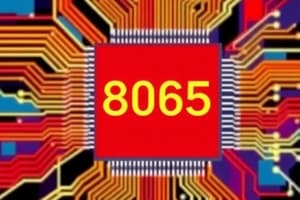Podcast
Questions and Answers
What year was the 8085 microprocessor developed by Intel?
What year was the 8085 microprocessor developed by Intel?
- 1977 (correct)
- 1975
- 1982
- 1980
Which data bus width does the 8085 microprocessor use?
Which data bus width does the 8085 microprocessor use?
- 8-bit (correct)
- 4-bit
- 16-bit
- 12-bit
What is the maximum memory addressing capability of the 8085 microprocessor?
What is the maximum memory addressing capability of the 8085 microprocessor?
- 32KB
- 256KB
- 64KB (correct)
- 128KB
What is the power supply voltage required by the 8085 microprocessor?
What is the power supply voltage required by the 8085 microprocessor?
Which feature distinguishes the 8085 from the 8080 microprocessor?
Which feature distinguishes the 8085 from the 8080 microprocessor?
What is the clock speed of the 8085 microprocessor?
What is the clock speed of the 8085 microprocessor?
What type of operations does the 8-bit ALU in the 8085 microprocessor perform?
What type of operations does the 8-bit ALU in the 8085 microprocessor perform?
Which of the following operations can the 8085 microprocessor perform?
Which of the following operations can the 8085 microprocessor perform?
What is the primary function of the ALU in the 8085 microprocessor?
What is the primary function of the ALU in the 8085 microprocessor?
Which register holds the address of the next program instruction in the 8085 microprocessor?
Which register holds the address of the next program instruction in the 8085 microprocessor?
What is the size of the data bus in the 8085 microprocessor?
What is the size of the data bus in the 8085 microprocessor?
Which of the following is NOT a part of the 8085 microprocessor's register set?
Which of the following is NOT a part of the 8085 microprocessor's register set?
Which signal allows the data bus to be activated during the 8085 operation?
Which signal allows the data bus to be activated during the 8085 operation?
What type of operations does the Timing and Control Unit manage in the 8085 microprocessor?
What type of operations does the Timing and Control Unit manage in the 8085 microprocessor?
How are the general-purpose registers in the 8085 microprocessor organized for 16-bit operations?
How are the general-purpose registers in the 8085 microprocessor organized for 16-bit operations?
What does the Flag Register in the 8085 microprocessor indicate?
What does the Flag Register in the 8085 microprocessor indicate?
Which of these signals indicate an interrupt acknowledgment in the 8085 microprocessor?
Which of these signals indicate an interrupt acknowledgment in the 8085 microprocessor?
What is the main function of the control bus in the 8085 microprocessor?
What is the main function of the control bus in the 8085 microprocessor?
Which register is specifically used to perform stack operations in the 8085 microprocessor?
Which register is specifically used to perform stack operations in the 8085 microprocessor?
What happens when the RESET IN signal is set to 0 in the 8085 microprocessor?
What happens when the RESET IN signal is set to 0 in the 8085 microprocessor?
How many bits does the accumulator in the 8085 microprocessor hold?
How many bits does the accumulator in the 8085 microprocessor hold?
What is the main function of the I/O Read operation in the 8085 microprocessor?
What is the main function of the I/O Read operation in the 8085 microprocessor?
Which addressing mode in the 8085 microprocessor uses a memory address directly to access data?
Which addressing mode in the 8085 microprocessor uses a memory address directly to access data?
What type of interrupt is TRAP considered in the 8085 microprocessor?
What type of interrupt is TRAP considered in the 8085 microprocessor?
Upon executing the RST 7.5 interrupt, where does the 8085 microprocessor store the Program Counter (PC) value?
Upon executing the RST 7.5 interrupt, where does the 8085 microprocessor store the Program Counter (PC) value?
What is the role of the Opcode Fetch Cycle in the 8085 microprocessor's machine cycles?
What is the role of the Opcode Fetch Cycle in the 8085 microprocessor's machine cycles?
How many total interrupt signals are there in the 8085 microprocessor?
How many total interrupt signals are there in the 8085 microprocessor?
In the 8085 microprocessor, what does the INTR signal signify?
In the 8085 microprocessor, what does the INTR signal signify?
Which of the following is NOT an application of the 8085 microprocessor?
Which of the following is NOT an application of the 8085 microprocessor?
Which machine cycle follows the Opcode Fetch Cycle if additional data is required?
Which machine cycle follows the Opcode Fetch Cycle if additional data is required?
What is the typical operating clock speed of the 8085 microprocessor?
What is the typical operating clock speed of the 8085 microprocessor?
Which interrupt in the 8085 microprocessor has the least priority?
Which interrupt in the 8085 microprocessor has the least priority?
Which control signal manages the direction of data flow in the 8085 microprocessor?
Which control signal manages the direction of data flow in the 8085 microprocessor?
What operation is performed during the Memory Write Cycle?
What operation is performed during the Memory Write Cycle?
How many types of machine cycles are there in the Intel 8085?
How many types of machine cycles are there in the Intel 8085?
Flashcards are hidden until you start studying
Study Notes
8085 Microprocessor Architecture
- Developed by Intel in 1977 using NMOS technology
- 8-bit data bus, 16-bit address bus (can address up to 64KB)
- Performs 8-bit operations with an 8-bit ALU
- Requires a +5V power supply and operates at 3.2 MHz
Internal Architecture
- ALU: Handles arithmetic and logical operations (add, subtract, AND, OR etc.)
- Includes an adder, shifter, and status register
- Timing and Control Unit: Manages data flow and memory access
- Generates timing, control, and status signals
- Registers:
- General-purpose registers (B, C, D, E, H, L): 8-bit each, paired for 16-bit operations (BC, DE, HL)
- Accumulator: 8-bit, stores results of ALU operations
- Flag Register: Contains five flags (CF, PF, ZF, SF, AC) used for program flow control
- PSW (Program Status Word): Accumulator and flag register combined
- Stack Pointer (SP): 16-bit, points to memory locations used as a stack
- Program Counter (PC): 16-bit, points to the next instruction to be executed
- Instruction Register/Decoder: Temporarily stores instructions and decodes them for execution
- Memory Address Register: Holds the address of the next instruction from PC
Pin Diagram
- Address/Data Bus (A0-A15): Unidirectional, sends addresses and data from microprocessor to peripherals
- Status and Control Signals:
- ALE (Address Latch Enable): Enables lower data bits during the T1 state of a machine cycle
- S0, S1: Status signals to indicate the bus operation (fetch, read, write, etc.)
- Clock Frequency and Power Supply:
- Vcc: +5V power supply
- Vss: Ground reference
- CLK (OUT): Clock signal for synchronizing operations
- X1, X2: Used to divide the frequency
- RESET Signals:
- RESET IN: Sets PC to 0 and enters the reset state when low
- RESET OUT: Used to reset the microprocessor and other devices
- Serial I/O Ports:
- SOD (Serial Output Data): Outputs serial data
- SID (Serial Input Data): Receives serial data
- Interrupts:
- INTR: Interrupt Request, a maskable interrupt
- INTA: Interrupt Acknowledge
- RST 7.5, RST 6.5, RST 5.5: Maskable interrupts with different priorities
- TRAP: Non-maskable interrupt, highest priority
- DMA Signals:
- HOLD: Request to relinquish control to a DMA device
- HLDA: Acknowledges the hold request
Addressing Modes
- Direct: Operands located at a specific memory address
- Register: Operands in processor registers
- Immediate: Operands provided directly with the instruction
- Indirect: Operands located at the address stored in a register pair
- Implicit: Addressing mode automatically implied by the instruction
Machine Cycles and Bus Timings
- Machine Cycles: Four basic cycles for instruction execution
- Opcode Fetch: Retrieves the instruction code from memory
- Memory Read: Reads data from memory if required
- Memory Write: Writes data to memory if required
- I/O Read/Write: Reads/writes data from/to input/output devices
- Bus Timings: Describe the timing characteristics of data transfers on the system buses
- Clock Speed: Typically 3 MHz, governs processing speed
- Bus Cycle Timing: Defines the timing of address, data, and control signals within each machine cycle
- Control Signals: Manage data flow and device operation
- Memory/I/O Timings: Specify timing requirements for memory and I/O interfaces
Applications of 8085 Microprocessor
- Instrumentation: Digital kiosks, security systems, function generators, etc.
- Entertainment: Gaming consoles, DVD players
- Communication: Digital telephones, satellite communication, telephone exchanges
- Home appliances: Ovens, washing machines, refrigerators
- Industrial control systems: Control various parameters like temperature, force, speed
- Military applications: Embedded systems, weapons control
- Data acquisition systems
Studying That Suits You
Use AI to generate personalized quizzes and flashcards to suit your learning preferences.





